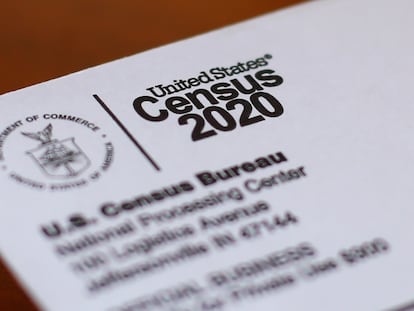Afro-Latinos fear being erased from next United States census
The ‘Latino/Hispanic Is Not A Race’ campaign challenges how the Census Bureau collects data on this community. According to the latest national count, there are 1.2 million Afro-Latinos, but the Pew Research Center puts the number at six million


Guesnerth Josué Perea remembers perfectly how he filled out the last United States census in 2020. Are you of Hispanic, Latino or Spanish origin? He checked “yes” and in the corresponding box wrote in that he’s Colombian. What is your race? He checked “Black.” He clearly identified himself as “an Afro-Latino of Colombian origin,” in his own words. But he’s convinced that the government did not count him as such. Instead, he was classified as being multirracial. “I know that because I wrote that I was born in Colombia, which they took as being a race in and of itself, and then they saw that I also put Black, so I was counted as multiracial. So, me, as a Black Colombian, I was categorized to be of more than one race, so I’m no longer counted as a Black individual,” he explains.
Perea, the executive director of the Afro Latino Forum, a research and resource center that centers on Blackness within the Latino community, points out that the Census Bureau has been miscalculating for at least two decades the number of Afro-Latinos residing in the United States. According to the latest census data, there are only 1.2 million. However, the Pew Research Center puts the number at 6 million. This discrepancy is due to how the government collects data on the community. Until a few months ago, Latinos had to answer two questions about their identity each time they filled out a federal questionnaire, as Perea did in 2020. They were first asked if they were Hispanic or Latino and then asked to choose a race: white, Black, Native American, Asian or “some other.”
However, last March the bureau announced that from now on Hispanic/Latino will be considered a race and ethnicity category, both in the upcoming 2030 census and in other similar questionnaires. With the change, the two questions are consolidated into one: What is your race and/or ethnicity? Respondents will be able to choose from seven options, including Hispanic or Latino, Black or white. The question adds that more than one box may be checked, although if only one box is checked — for example, Hispanic or Latino — it will be considered a complete response.
In announcing the new method, the bureau explained that the change reflects the results of the 2020 census, in which most Latinos did not mark their race as white, Black or Asian and instead tended to choose the “some other race” option or not answer the second question at all. Specifically, 42% of the 62 million Latinos surveyed in 2020 chose the “some other race” category. “For the past several decades, the ‘some other race’ population has increased, largely driven by the increase in the Hispanic population which could not easily report its Hispanic identity in the separate race question,” the federal agency stated. In addition, the bureau justified the change by pointing out that several studies show that Latinos prefer to identify themselves simply by their ethnicity, not their race.

The new standard was applauded by organizations that for years have advocated for a single category for Latinos, considering the two-part question flawed and confusing for Latinos. However, Afro-Latino advocacy groups see it as problematic. To begin with, they point out that race and ethnicity are two distinct concepts. They are not categories that can be used interchangeably in the same list, as the Census Bureau suggests. Nancy López, a sociologist and professor at the University of New Mexico and a collaborator with the Afro Latino Forum and the Afro Latino Coalition, explains the difference: “Race has to do with a person’s appearance, with physical traits such as skin color and hair texture. It is a social status. Ethnicity has to do with the cultural heritage of our countries.”
The main problem, López points out, is that the Census Bureau, in its questionnaires, has never stopped to “clarify the difference” between the two concepts. Therefore, Latinos surveyed, whether Black or not, have answered the question as best they could with the little information at hand. But that does not mean that Latinos are unaware of their racial identity, the expert stresses. “It’s not true that people don’t know their race,” she says. What is true, she adds, is that the bureau has tried to systematically manipulate Latino respondents by asking them questions without explaining them. Lopez calls it “statistical gaslighting.”
One single question
Instead of keeping ethnicity and race separate and explaining the difference between the two questions, as many experts have been recommending for years, the Census Bureau opted to combine both concepts into one question. Afro-Latino researchers like Tanya Katerí Hernández explain that the change will end up confusing people more. “When you put Latino/Hispanic in the same list with racial categories, that leads the Latino to think, ‘Oh, those are the categories for English-speaking Americans. They don’t mean me because my box is the Latino box,’” says the Fordham University School of Law professor and author of the book Racial Innocence: Unmasking Latino Anti-Black Bias and the Struggle for Equality.
That is, many Latinos will check their box and skip the others, regardless of their race. They will do so because they believe that the other racial categories do not include them. According to Hernández, when a Latino sees the category of white on the census, they think it refers to “white Americans, the descendants of the first English-speaking settlers who came to America. Similarly, when they see Black, they think it refers only to African Americans.” Therefore, the new question will lead to the erasure of Afro-Latinos in the statistics and an undervaluation of racial diversity within the Latino community.
“It’s a way to have people disinclined to check multiple boxes even though it’s available to them. The framing of the question doesn’t encourage it, so you’re going to get less data about the way race affects Latinos,” Hernández points out. “The prior census framing that kept Hispanic ethnicity separate from race at least enabled us to get at the ways in which racism makes a difference within Latinidad. That even though all of us can be exposed to ethnic discrimination, not all of us are exposed to the same kind of skin color, racial discrimination,” she adds.
Whether there is one question or two and how they are phrased matters because census data, in addition to being a count of the country’s population, also reflects the discrimination faced by different groups and whether or not civil rights are protected. “These data help us understand whether there is inequality in voting, whether there is inequality in access to fair housing, whether or not there is employment discrimination, whether or not there is equal opportunity in education,” López explains. In addition, although the change in the categorization of ethnicity and race was made at the federal level, the effect goes beyond that. Many researchers, state and local governments and non-profit organizations use the census figures for various projects and campaigns.
For her, the ideal solution would be to have three distinct questions: Are you Latino or Hispanic? What country are you from? What is your race? “And specify that by race we mean your social status, which has to do with your physical features, mainly your skin color, not your cultural heritage,” adds the sociologist.

The “other race” problem
Between the 2010 and 2020 census, a total of 45 million Latinos checked the “some other race” box, or wrote an answer that the Census Bureau classified in that category. In that decade, the number of Latinos counted as “some other race” rose by 41.7%. That increase concerned many researchers, who felt that the data were failing to reflect the racial identity of the Latino community. Therefore, the government agreed to revise the way Latinos were being asked about their race and ethnicity.
The new question approved in March is supposed to remedy this problem and get the percentage of Latinos identifying with “some other race” to decrease. However, experts like Hernández believe that the government “took a shortcut.” The change in the question, Hernández adds, does nothing to address why 42% of Latinos chose that option to begin with. “Now those 42% of people can check Hispanic and keep moving. It was a way to shut down that ‘other race’ business, but they did so by sacrificing the purposes of the census racial data, which is to enforce civil rights.”
At the same time, Hernández highlights the other side of that statistic: if 42% of Latinos surveyed picked the “some other race” option, that means that the rest did choose at least one of the races included in the list. “That data means that there are almost 60% of Latinos who did answer the race question. That means they got no problem telling you that we’re white, that we’re Black, that we’re Asian, etc., in addition to being Latino,” she points out.
Educating the community
Although the change in the question was approved, federal agencies have 18 months to develop compliance plans and up to five years to implement them. Therefore,the Afro-Latino Forum vows that they will continue to put up a fight. “Given the terrible way in which the question is now framed, the burden is on us Latinos to educate the population about the need for multiple-box checking,” Hernández says. One of the ways they will raise awareness in the Latino community will be through the Latino/Hispanic Is Not A Race campaign, which counts with more than 45 organizations across the country.
“At the same time we will continue to lobby the Census Bureau to properly code Latinos’ responses. It’s one thing to encourage Afro-Latinos to check multiple boxes, for Black and Latino, but that doesn’t guarantee what the Census Bureau does with the data,” Hernández adds. She’s referring to what happened to Guesnerth Josué Perea when he filled out the last census in 2020. Like him, thousands of Afro-Latinos were misclassified as multiracial.
Perea recommends evaluating how Pew collects its data on Afro-Latinos. In its latest 2022 report, Pew researchers concluded that, rather than using a two-part question like the one the Census Bureau employed until recently, “asking directly about Afro-Latino identity yields a higher share of respondents who identify” as such. In other words, cutting to the chase: Are you Afro-Latino or Afro-Latina? According to Pew, six million people would say yes, 12% of the entire Latino population in the country.
Sign up for our weekly newsletter to get more English-language news coverage from EL PAÍS USA Edition
Tu suscripción se está usando en otro dispositivo
¿Quieres añadir otro usuario a tu suscripción?
Si continúas leyendo en este dispositivo, no se podrá leer en el otro.
FlechaTu suscripción se está usando en otro dispositivo y solo puedes acceder a EL PAÍS desde un dispositivo a la vez.
Si quieres compartir tu cuenta, cambia tu suscripción a la modalidad Premium, así podrás añadir otro usuario. Cada uno accederá con su propia cuenta de email, lo que os permitirá personalizar vuestra experiencia en EL PAÍS.
¿Tienes una suscripción de empresa? Accede aquí para contratar más cuentas.
En el caso de no saber quién está usando tu cuenta, te recomendamos cambiar tu contraseña aquí.
Si decides continuar compartiendo tu cuenta, este mensaje se mostrará en tu dispositivo y en el de la otra persona que está usando tu cuenta de forma indefinida, afectando a tu experiencia de lectura. Puedes consultar aquí los términos y condiciones de la suscripción digital.
More information
Archived In
Últimas noticias
Most viewed
- Alain Aspect, Nobel laureate in physics: ‘Einstein was so smart that he would have had to recognize quantum entanglement’
- Mexico’s missing people crisis casts a shadow over World Cup venue
- Why oil has been at the center of Venezuela-US conflicts for decades
- Trump clarifies who is ultimately in charge in Venezuela: ‘Me’
- Mexico seeks to shore up its defenses following US incursion in Venezuela










































